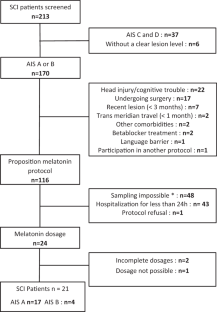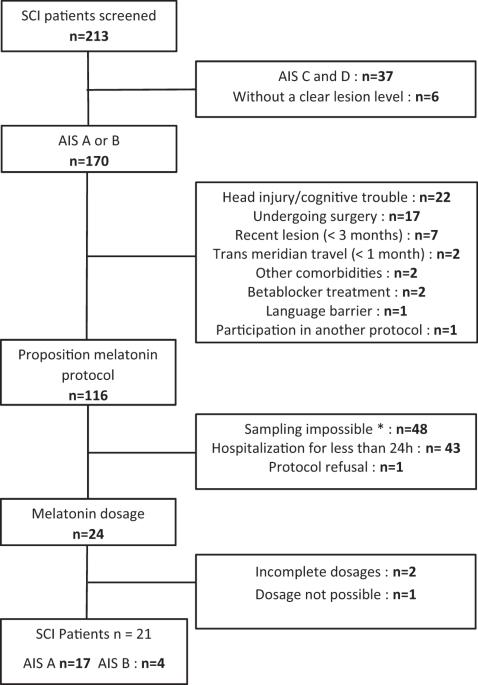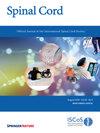脊髓损伤患者的褪黑激素分泌和睡眠障碍。
IF 2.1
4区 医学
Q3 CLINICAL NEUROLOGY
引用次数: 0
摘要
研究设计前瞻性观察研究:评估脊髓损伤(SCI)患者的褪黑激素分泌、白天嗜睡和睡眠障碍及其与病变程度的关系:方法:对因脊髓损伤住院的 18 岁以上患者进行前瞻性观察研究。采用匹兹堡睡眠质量指数(PQSI)测量睡眠质量,采用埃普沃思嗜睡量表(ESS)测量白天嗜睡情况,采用 24 小时尿液中 6-硫氧褪黑素的剂量测量褪黑素分泌情况:结果:共筛选出 213 名患者,其中 21 名患者:17 名完全瘫痪(AIS A),4 名病变(AIS B),76%为外伤所致,12 名四肢瘫痪,9 名截瘫,平均伤后 10 年(0.5-40 年不等)。平均年龄为 46.8 ± 14.7 岁,平均体重指数为 23.56 ± 4.1,男性多于女性(15 对 6)。褪黑激素的分泌通过24小时分泌量和分泌曲线进行分析。比较保留分泌与取消分泌,T8以上病变的患者中只有23%(4/17)保留了褪黑激素分泌,而T8以下病变的患者中则有80%(4/5)保留了褪黑激素分泌(p = 0.022)。在保留分泌的患者的分泌情况中发现了非显性差异:T8以上病变的患者中没有人有正常的分泌情况,而T8以下病变的患者中有50%有正常的分泌情况;在T8以上部分病变与全部病变的影响中,17%(2/12)的完全ASIA-A病变患者和50%(2/4)的不完全病变患者保留了分泌:结论:T8以上的脊髓病变与褪黑激素分泌消失密切相关。本文章由计算机程序翻译,如有差异,请以英文原文为准。


Melatonin secretion and sleep disorders in patients with spinal cord injuries
Prospective observational study. To evaluate melatonin secretion, daytime sleepiness and sleep disorders in patients with spinal cord injuries (SCI), and their association with lesion level. Specialized neuro rehabilitation hospital in France Prospective observational study of patients aged over 18 hospitalized in for spinal cord injury. Sleep quality was measured with the Pittsburgh Sleep Quality Index (PQSI), daytime sleepiness with the Epworth Sleepiness scale (ESS), and melatonin secretion by 24 h urinary dosage of 6-sulphatoxy-melatonin. 213 patients were screened, 21 patients were included: 17 complete (AIS A) and 4 lesions (AIS B), 76% of traumatic origin with 12 tetraplegic and 9 paraplegic, mean 10 (range 0.5–40) years after injury. Mean age was 46.8 ± 14.7 years, mean BMI 23.56 ± 4.1 and men outnumbered women (15 vs 6). Melatonin secretion was analyzed by 24 h secretion and by secretion profile. Comparing retained vs abolished secretion, only 23% (4/17) of patients with a lesion above T8 retained melatonin secretion, compared to 80% (4/5) with a lesion below T8 (p = 0.022). Non significant differences were found in secretion profile in patients who retained secretion: no patient with a lesion above T8 had a normal secretion profile compared to 50% with a lesion below T8 and in the impact of partial vs total lesions above T8 in whom 17% (2/12) of complete ASIA-A lesions and 50% (2/4) of incomplete lesions retained secretion. Lesions of the spinal cord above T8 are strongly associated with abolition of melatonin secretion.
求助全文
通过发布文献求助,成功后即可免费获取论文全文。
去求助
来源期刊

Spinal cord
医学-临床神经学
CiteScore
4.50
自引率
9.10%
发文量
142
审稿时长
2 months
期刊介绍:
Spinal Cord is a specialised, international journal that has been publishing spinal cord related manuscripts since 1963. It appears monthly, online and in print, and accepts contributions on spinal cord anatomy, physiology, management of injury and disease, and the quality of life and life circumstances of people with a spinal cord injury. Spinal Cord is multi-disciplinary and publishes contributions across the entire spectrum of research ranging from basic science to applied clinical research. It focuses on high quality original research, systematic reviews and narrative reviews.
Spinal Cord''s sister journal Spinal Cord Series and Cases: Clinical Management in Spinal Cord Disorders publishes high quality case reports, small case series, pilot and retrospective studies perspectives, Pulse survey articles, Point-couterpoint articles, correspondences and book reviews. It specialises in material that addresses all aspects of life for persons with spinal cord injuries or disorders. For more information, please see the aims and scope of Spinal Cord Series and Cases.
 求助内容:
求助内容: 应助结果提醒方式:
应助结果提醒方式:


